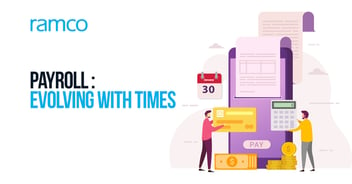
- Home
- Global Payroll
- Internal Policy Updates: Role of Change Management in BAU Payroll
Internal Policy Updates: Role of Change Management in BAU Payroll
Published :

Effective change management is vital in payroll processes, even when no system or vendor changes occur, to ensure Business As Usual (BAU) is carried out smoothly. In our previous blog, we discussed the importance of change management in the context of external factors that can impact payroll processes. Now, let's delve into how internal changes within an organization can also affect payroll calculations and require effective change management strategies.
From updates in HR systems to the introduction of new pay elements, internal changes can have a significant impact on payroll systems. To ensure accuracy and compliance, organizations must have robust change management processes in place that facilitate collaboration between different departments and ensure seamless implementation of these changes.
A payroll system is affected when changes are made by other departments, such as when finance updates the General Ledger (GL) system and requires a new GL file format from the payroll team when the HR department updates the HRIS, Time, Absence, or other systems, or a new pay element is added.
The payroll team must collaborate closely with these departments to ensure the necessary adjustments are made in the payroll system and change management must ensure seamless communication between all the departments.
Here are a few examples of how changes in different departments can impact payroll calculations and how change management can help:
When a new pay element is added, there are several important steps to ensure the change is implemented smoothly.
What needs to be communicated: It's essential to inform employees about the new pay element and how it will affect their overall compensation. Change management must clarify whether this is a one-time addition or a permanent change to their pay.
Who should be communicated to: Determine if the new pay element impacts all employees or a specific group. For example, if a new pay element is related to “Retention of Customer” and applies only to Customer Success Managers (CSMs) or Sales representatives, change management must ensure this is communicated only to those roles to avoid confusion among other employees.
When a new pay element is added or changes are made to an existing one, it's essential for change management to check the following:
By thoroughly verifying these aspects, organizations can ensure that any changes to pay elements are accurately implemented, maintaining compliance and preventing payroll errors.
When there are changes in benefits offerings, such as healthcare plans or retirement contributions, change management ensures that payroll systems are updated to accurately reflect the new deduction amounts. This prevents errors in employee paychecks and maintains compliance with regulatory requirements.
Even annual compensation changes, such as those from appraisals, are a crucial part of change management. HR teams typically inform employees about when the new salary will take effect and whether there will be any arrears. To ensure a smooth transition, change management must ensure payroll teams collaborate with HR to make sure the following steps are covered:
By following these steps, organizations can ensure a seamless transition during appraisal periods and maintain compliance.
For updates to leave policies, such as changes in vacation, sick leave, or parental leave, change management ensures that payroll systems are adjusted to comply with the new policies. This includes recalculating accruals and deductions to match the updated leave entitlements.
In the BAU stage of payroll, change management plays a crucial role in maintaining smooth operations. Even without a major transition in payroll systems or vendors, adjustments from other departments require careful management and timely communication. Proactive change management is vital for adapting to these changes, updating payroll systems, and informing employees of any impacts on their salaries or benefits. Organizations can prevent disruptions, maintain positive employee experience, and uphold compliance with regulatory requirements by ensuring clear communication and coordination among all stakeholders.
Enterprise asset management (EAM) involves the management of mission critical assets of an organization throughout each asset's lifecycle. EAM is used to plan, optimize, execute, and track the needed maintenance activities with the associated priorities, skills, materials, tools, and information. The aim is to optimize the quality and utilization of assets throughout their lifecycle, increase productive uptime and reduce operational costs.
Enterprise asset management (EAM) involves the management of the maintenance of physical assets of an organization throughout each asset's lifecycle. EAM is used to plan, optimize, execute, and track the needed maintenance activities with the associated priorities, skills, materials, tools, and information.
The software helps in effective maintenance of assets through preventive, predictive, shutdown and breakdown maintenance strategies. The system also helps enterprises mitigate equipment risks by enhanced safety standards. The streamlined operations and improved asset performance helps organizations increase their investment effectiveness.
EAM is important because it helps organizations track, assess, manage and optimize asset quality and reliability. Asset intensive Organizations have hundreds, thousands, even millions of assets which needs to be maintained to maximize / optimize life of these assets to increase the return on investment.
The key features of effective EAM are:
Asset Intensive companies under the following Industries :
Contact us for a meeting and schedule a demo
This differs on case to case basis, based on the type of installation and unique industry specific requirements. Contact us for a meeting and schedule a demo.
This differs on case to case basis, based on the type of installation and unique industry specific requirements. Contact us for a meeting and schedule a demo.
Stay Connected, follow us on LinkedIn / Twitter to know more about EAM Software latest trends.

All Rights Reserved. © Copyright 2024. Ramco Systems.